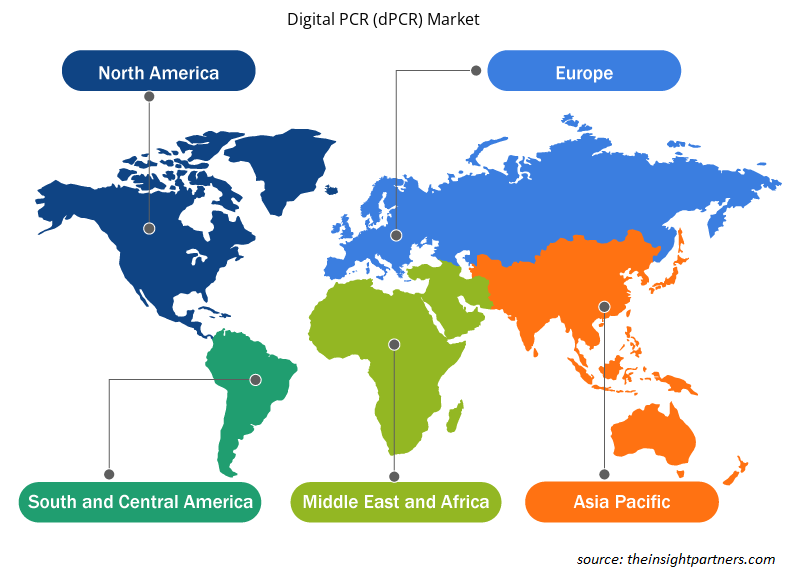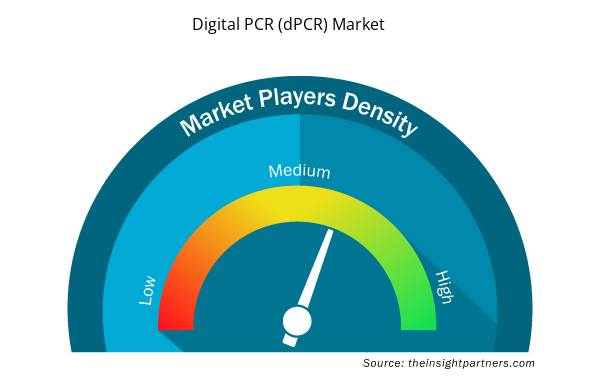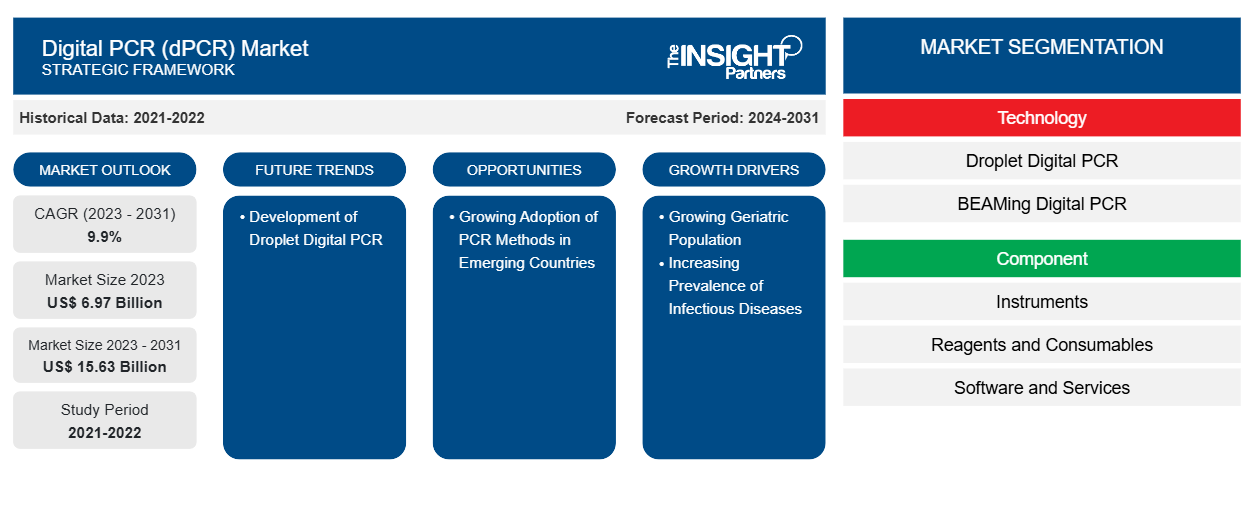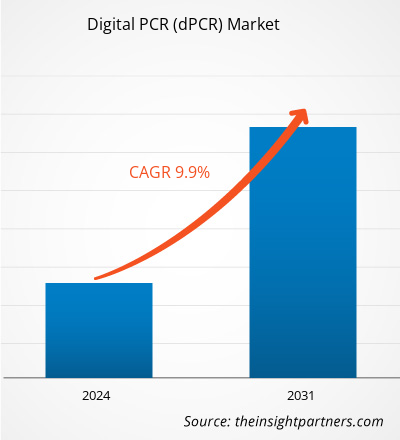Das Marktvolumen für digitale PCR (dPCR) soll von 6,97 Milliarden US-Dollar im Jahr 2023 auf 15,63 Milliarden US-Dollar im Jahr 2031 anwachsen; für den Zeitraum 2023–2031 wird eine durchschnittliche jährliche Wachstumsrate (CAGR) von 9,9 % erwartet.
dPCR ist eine bahnbrechende Technologie, die eine ultraempfindliche und absolute Nukleinsäurequantifizierung ermöglicht. Es ist eine der genauesten, präzisesten und empfindlichsten Techniken zum Nachweis spezifischer Nukleinsäuresequenzen. Es ist zu einem wichtigen und zuverlässigen Werkzeug für die molekulare Analyse geworden. Die zunehmende Häufigkeit genetischer und infektiöser Krankheiten, die mit dPCR-Techniken diagnostiziert und behandelt werden können, unterstützt das Wachstum des Marktes für digitale PCR (dPCR) . Zu den Markttrends für digitale PCR (dPCR) gehören technologische Fortschritte, die eine hochpräzise und absolute Quantifizierung von Ziel-DNA-Molekülen unterstützen und so ein breites Anwendungsspektrum in Diagnose und Forschung ermöglichen.
Wachstumstreiber:
Die Gensynthese ist das am weitesten verbreitete Werkzeug im Bereich der rekombinanten DNA-Technologie. Bei der Gensynthese werden rekombinante Proteinexpression und dPCR-Technologie sowohl zur Amplifikation als auch zur Quantifizierung eingesetzt. Im Jahr 2021 schloss Camena Bioscience, ein Startup für synthetische Biologie, das die Biotechnologie- und Pharmaindustrie mit Genen versorgt, eine von Mercia angeführte Finanzierungsrunde der Serie A in Höhe von 10 Millionen US-Dollar ab. Mit den zusätzlichen Mitteln plant das Unternehmen, seine Geschäftstätigkeit auszuweiten und seine Bemühungen zur Entwicklung von gSynth, seiner bahnbrechenden DNA-Syntheseplattform, voranzutreiben. Die Technologieplattform und andere damit verbundene Ressourcen helfen dem Unternehmen, die Entwicklung der Gensynthese zu beschleunigen.
Im Jahr 2020 gab EVONETIX LTD, ein Startup für synthetische Biologie, das eine Desktop-Plattform für hochpräzise, schnelle und skalierbare Gensynthese entwickelt, den Abschluss seiner Finanzierungsrunde der Serie B bekannt. Das von Foresite Capital (einem neuen Investor) geführte Unternehmen sammelte in dieser Runde 30 Millionen US-Dollar (23 Millionen Pfund) ein. Steigende Investitionen von Unternehmen treiben also das Wachstum des Marktes für Gensynthese an und tragen so zum Wachstum des Marktes für digitale PCR (dPCR) bei.
Passen Sie diesen Bericht Ihren Anforderungen an
Sie erhalten kostenlose Anpassungen an jedem Bericht, einschließlich Teilen dieses Berichts oder einer Analyse auf Länderebene, eines Excel-Datenpakets sowie tolle Angebote und Rabatte für Start-ups und Universitäten.
- Holen Sie sich die wichtigsten Markttrends aus diesem Bericht.Dieses KOSTENLOSE Beispiel umfasst eine Datenanalyse von Markttrends bis hin zu Schätzungen und Prognosen.
Berichtssegmentierung und -umfang:
Die Marktanalyse für digitale PCR (dPCR) wurde unter Berücksichtigung der folgenden Segmente durchgeführt: Technologie, Komponente, Anwendung, Endbenutzer und Geografie. Basierend auf der Technologie ist der Markt in Droplet Digital PCR (ddPCR) und BEAMing Digital PCR segmentiert. In Bezug auf die Komponente ist der Markt in Instrumente, Reagenzien und Verbrauchsmaterialien sowie Software und Dienstleistungen unterteilt. Basierend auf der Anwendung ist der Markt in Klinik, Forschung und Forensik kategorisiert. Der geografische Umfang des Marktberichts für digitale PCR (dPCR) umfasst Nordamerika (USA, Kanada und Mexiko), Europa (Frankreich, Deutschland, Großbritannien, Spanien, Italien und Rest von Europa), Asien-Pazifik (China, Japan, Indien, Südkorea, Australien und Rest von Asien-Pazifik), den Nahen Osten und Afrika (Saudi-Arabien, Südafrika, Vereinigte Arabische Emirate und Rest von Nahem Osten und Afrika) sowie Süd- und Mittelamerika (Brasilien, Argentinien und Rest von Süd- und Mittelamerika).
Segmentanalyse:
Der Markt für digitale PCR (dPCR) wird nach Produkten in Droplet Digital PCR (ddPCR) und BEAMing Digital PCR unterteilt. Das ddPCR-Segment hatte 2023 einen bedeutenden Marktanteil. Es wird erwartet, dass es zwischen 2023 und 2031 die höchste CAGR auf dem Markt verzeichnet.
Basierend auf den Komponenten wird der Markt in Instrumente, Reagenzien und Verbrauchsmaterialien sowie Software und Serviceangaben unterteilt. Das Segment Reagenzien und Verbrauchsmaterialien hatte 2023 einen bedeutenden Marktanteil und wird voraussichtlich zwischen 2023 und 2031 die höchste durchschnittliche jährliche Wachstumsrate verzeichnen.
Basierend auf der Anwendung ist der Markt in Klinik, Forschung und Forensik segmentiert. Das klinische Segment hielt 2023 einen bedeutenden Marktanteil bei der digitalen PCR (dPCR); es wird erwartet, dass es zwischen 2023 und 2031 die höchste durchschnittliche jährliche Wachstumsrate verzeichnet.
Basierend auf dem Endverbraucher ist der Markt in Krankenhäuser und Diagnosezentren, Pharma- und Biotechunternehmen, Forschungslabore und akademische Institute, forensische Labore und klinische Forschungsorganisationen segmentiert. Das Segment Krankenhäuser und Diagnosezentren hielt im Jahr 2023 einen bedeutenden Marktanteil bei der digitalen PCR (dPCR); es wird erwartet, dass es zwischen 2023 und 2031 die höchste durchschnittliche jährliche Wachstumsrate verzeichnet.
Regionale Analyse:
Geografisch ist der Markt für digitale PCR (dPCR) in Nordamerika, Europa, Asien-Pazifik, Süd- und Mittelamerika sowie den Nahen Osten und Afrika unterteilt. Im Jahr 2023 eroberte Nordamerika einen bedeutenden Marktanteil. Im Jahr 2023 dominierten die USA den Markt in dieser Region. Das Wachstum des Marktes für digitale PCR (dPCR) in Nordamerika ist auf wissenschaftliche Konferenzen, Workshops und Veranstaltungen in den USA und Kanada zurückzuführen, die Teilnehmern aus verschiedenen Teilen der Welt helfen, Trends und die neuesten Forschungsergebnisse auf der Grundlage von PCR auszutauschen. So veranstaltete Global Engage von Global Information Incorporation beispielsweise einen zweitägigen Gipfel, bei dem der Beitrag von Wissenschaftlern aus aller Welt zu dPCR-Strategien und -Entwicklungen vorgestellt und Fallstudien diskutiert wurden, die den Beitrag von dPCR im Gesundheitswesen beinhalten. Das aktive Engagement des Landes ist auch einer der treibenden Faktoren, die zum Wachstum der Region auf dem globalen Markt für digitale PCR (dPCR) in der Region führen.
Branchenentwicklungen und zukünftige Chancen:
Der Marktbericht zur digitalen PCR (dPCR) umfasst die Positionierung und Konzentration des Unternehmens, um die Leistung der Wettbewerber auf dem Markt zu bewerten. Laut Pressemitteilungen des Unternehmens sind im Folgenden einige Initiativen der wichtigsten Akteure auf dem Markt aufgeführt:
- Im Juli 2023 brachte Bio-Rad Laboratories, Inc. seinen ersten ultrasensitiven Multiplex-dPCR-Test auf den Markt – das ddPLEX ESR1 Mutation Detection Kit. Mit der Markteinführung dieses Produkts plant das Unternehmen, die Verfügbarkeit seines ddPCR-Angebots für den Onkologiemarkt zu erweitern, wo hochsensitive und Multiplex-Mutationserkennungstests die translationale Forschung, die Therapieauswahl und die Krankheitsüberwachung unterstützen.
- Im Juni 2021 stellte Bio-Rad Laboratories Inc. das „Prevalence ddPCR SARS-CoV-2 Wastewater Quantification Kit“ vor, ein empfindliches, kostengünstiges und genaues Instrument zum Nachweis von SARS-CoV-2 im kommunalen Abwasser.
- Die Centers for Disease Control and Prevention (CDC) empfehlen ddPCR-Techniken zur Untersuchung von Abwasser und die Environmental Protection Agency (EPA) hat die Technologie als zuverlässige Methode zur Quantifizierung von Viren im Abwasser veröffentlicht.
Regionale Einblicke in den Markt für digitale PCR (dPCR)
Die regionalen Trends und Faktoren, die den Markt für digitale PCR (dPCR) während des gesamten Prognosezeitraums beeinflussen, wurden von den Analysten von Insight Partners ausführlich erläutert. In diesem Abschnitt werden auch die Marktsegmente und die Geografie für digitale PCR (dPCR) in Nordamerika, Europa, im asiatisch-pazifischen Raum, im Nahen Osten und Afrika sowie in Süd- und Mittelamerika erörtert.

- Erhalten Sie regionale Daten zum Markt für digitale PCR (dPCR)
Umfang des Marktberichts zur digitalen PCR (dPCR)
| Berichtsattribut | Details |
|---|---|
| Marktgröße im Jahr 2023 | 6,97 Milliarden US-Dollar |
| Marktgröße bis 2031 | 15,63 Milliarden US-Dollar |
| Globale CAGR (2023 - 2031) | 9,9 % |
| Historische Daten | 2021-2022 |
| Prognosezeitraum | 2024–2031 |
| Abgedeckte Segmente | Nach Technologie
|
| Abgedeckte Regionen und Länder | Nordamerika
|
| Marktführer und wichtige Unternehmensprofile |
|
Marktteilnehmerdichte für digitale PCR (dPCR): Auswirkungen auf die Geschäftsdynamik verstehen
Der Markt für digitale PCR (dPCR) wächst rasant, angetrieben durch die steigende Nachfrage der Endnutzer aufgrund von Faktoren wie sich entwickelnden Verbraucherpräferenzen, technologischen Fortschritten und einem größeren Bewusstsein für die Vorteile des Produkts. Mit steigender Nachfrage erweitern Unternehmen ihr Angebot, entwickeln Innovationen, um die Bedürfnisse der Verbraucher zu erfüllen, und nutzen neue Trends, was das Marktwachstum weiter ankurbelt.
Die Marktteilnehmerdichte bezieht sich auf die Verteilung der Firmen oder Unternehmen, die in einem bestimmten Markt oder einer bestimmten Branche tätig sind. Sie gibt an, wie viele Wettbewerber (Marktteilnehmer) in einem bestimmten Marktraum im Verhältnis zu seiner Größe oder seinem gesamten Marktwert präsent sind.
Die wichtigsten Unternehmen auf dem Markt für digitale PCR (dPCR) sind:
- Thermo Fisher Scientific, Inc.
- F. Hoffmann-la Roche Ltd.
- QIAGEN
- Akara Bio, Inc.
- Agilent Technologies, Inc.
Haftungsausschluss : Die oben aufgeführten Unternehmen sind nicht in einer bestimmten Reihenfolge aufgeführt.

- Überblick über die wichtigsten Akteure auf dem Markt für digitale PCR (dPCR)
Wettbewerbslandschaft und Schlüsselunternehmen:
Die Marktprognose für digitale PCR (dPCR) kann Stakeholdern bei der Planung ihrer Wachstumsstrategien helfen. Thermo Fisher Scientific, Inc.; F. Hoffmann-la Roche Ltd.; QIAGEN; Akara bio, Inc.; Agilent Technologies, Inc.; Biomerieux SA; Abbott Laboratories; Merck KgaA; Promega Corporation; und BD gehören zu den führenden Akteuren auf dem Markt. Diese Unternehmen konzentrieren sich auf die Einführung neuer Hightech-Produkte, die Weiterentwicklung bestehender Produkte und die geografische Expansion, um die weltweit wachsende Verbrauchernachfrage zu erfüllen.
- Historische Analyse (2 Jahre), Basisjahr, Prognose (7 Jahre) mit CAGR
- PEST- und SWOT-Analyse
- Marktgröße Wert/Volumen – Global, Regional, Land
- Branche und Wettbewerbsumfeld
- Excel-Datensatz



Report Coverage
Revenue forecast, Company Analysis, Industry landscape, Growth factors, and Trends

Segment Covered
This text is related
to segments covered.

Regional Scope
North America, Europe, Asia Pacific, Middle East & Africa, South & Central America

Country Scope
This text is related
to country scope.
Häufig gestellte Fragen
dPCR is a new technique utilized for DNA amplification and quantification that uses molecular counting protocol. dPCR is usually used to distinguish the expression of alleles, track viral infection to individual bacterial cells, quantify cancer genes, and detect fetal DNA in circulating blood.
The Digital PCR (dPCR) market is expected to be valued at US$ 15.63 billion by 2031.
The global Digital PCR (dPCR) market is segmented based on technology, component, application, and end user. The Digital PCR (dPCR) market, by component, is categorized into instruments, reagents and consumables, and software and services. The reagents and consumables segment held a significant market share in 2023 and is anticipated to record the highest CAGR in the market during 2023–2031.
The factors driving the growth of the Digital PCR (dPCR) market include the rising incidence of infectious diseases and technological advancements in PCR technologies. However, the high costs of PCR systems, hampers the growth of the Digital PCR (dPCR) market.
The Digital PCR (dPCR) market was valued at US$ 6.97 billion in 2023.
The Digital PCR (dPCR) market majorly consists of the players, including Thermo Fisher Scientific, Inc.; F. Hoffmann-la Roche Ltd.; QIAGEN; Akara bio, Inc.; Agilent Technologies, Inc.; Biomerieux SA; Abbott Laboratories; Merck KgaA; Promega Corporation; and BD.
Trends and growth analysis reports related to Life Sciences : READ MORE..
The List of Companies - Digital PCR (dPCR) Market
- Thermo Fisher Scientific, Inc.
- F. Hoffmann-la Roche Ltd
- QIAGEN
- Akara bio, Inc.
- Agilent Technologies, Inc.
- Biomerieux SA
- Abbott Laboratories
- Merck KgaA
- Promega Corporation
- BD.
The Insight Partners performs research in 4 major stages: Data Collection & Secondary Research, Primary Research, Data Analysis and Data Triangulation & Final Review.
- Data Collection and Secondary Research:
As a market research and consulting firm operating from a decade, we have published and advised several client across the globe. First step for any study will start with an assessment of currently available data and insights from existing reports. Further, historical and current market information is collected from Investor Presentations, Annual Reports, SEC Filings, etc., and other information related to company’s performance and market positioning are gathered from Paid Databases (Factiva, Hoovers, and Reuters) and various other publications available in public domain.
Several associations trade associates, technical forums, institutes, societies and organization are accessed to gain technical as well as market related insights through their publications such as research papers, blogs and press releases related to the studies are referred to get cues about the market. Further, white papers, journals, magazines, and other news articles published in last 3 years are scrutinized and analyzed to understand the current market trends.
- Primary Research:
The primarily interview analysis comprise of data obtained from industry participants interview and answers to survey questions gathered by in-house primary team.
For primary research, interviews are conducted with industry experts/CEOs/Marketing Managers/VPs/Subject Matter Experts from both demand and supply side to get a 360-degree view of the market. The primary team conducts several interviews based on the complexity of the markets to understand the various market trends and dynamics which makes research more credible and precise.
A typical research interview fulfils the following functions:
- Provides first-hand information on the market size, market trends, growth trends, competitive landscape, and outlook
- Validates and strengthens in-house secondary research findings
- Develops the analysis team’s expertise and market understanding
Primary research involves email interactions and telephone interviews for each market, category, segment, and sub-segment across geographies. The participants who typically take part in such a process include, but are not limited to:
- Industry participants: VPs, business development managers, market intelligence managers and national sales managers
- Outside experts: Valuation experts, research analysts and key opinion leaders specializing in the electronics and semiconductor industry.
Below is the breakup of our primary respondents by company, designation, and region:

Once we receive the confirmation from primary research sources or primary respondents, we finalize the base year market estimation and forecast the data as per the macroeconomic and microeconomic factors assessed during data collection.
- Data Analysis:
Once data is validated through both secondary as well as primary respondents, we finalize the market estimations by hypothesis formulation and factor analysis at regional and country level.
- Macro-Economic Factor Analysis:
We analyse macroeconomic indicators such the gross domestic product (GDP), increase in the demand for goods and services across industries, technological advancement, regional economic growth, governmental policies, the influence of COVID-19, PEST analysis, and other aspects. This analysis aids in setting benchmarks for various nations/regions and approximating market splits. Additionally, the general trend of the aforementioned components aid in determining the market's development possibilities.
- Country Level Data:
Various factors that are especially aligned to the country are taken into account to determine the market size for a certain area and country, including the presence of vendors, such as headquarters and offices, the country's GDP, demand patterns, and industry growth. To comprehend the market dynamics for the nation, a number of growth variables, inhibitors, application areas, and current market trends are researched. The aforementioned elements aid in determining the country's overall market's growth potential.
- Company Profile:
The “Table of Contents” is formulated by listing and analyzing more than 25 - 30 companies operating in the market ecosystem across geographies. However, we profile only 10 companies as a standard practice in our syndicate reports. These 10 companies comprise leading, emerging, and regional players. Nonetheless, our analysis is not restricted to the 10 listed companies, we also analyze other companies present in the market to develop a holistic view and understand the prevailing trends. The “Company Profiles” section in the report covers key facts, business description, products & services, financial information, SWOT analysis, and key developments. The financial information presented is extracted from the annual reports and official documents of the publicly listed companies. Upon collecting the information for the sections of respective companies, we verify them via various primary sources and then compile the data in respective company profiles. The company level information helps us in deriving the base number as well as in forecasting the market size.
- Developing Base Number:
Aggregation of sales statistics (2020-2022) and macro-economic factor, and other secondary and primary research insights are utilized to arrive at base number and related market shares for 2022. The data gaps are identified in this step and relevant market data is analyzed, collected from paid primary interviews or databases. On finalizing the base year market size, forecasts are developed on the basis of macro-economic, industry and market growth factors and company level analysis.
- Data Triangulation and Final Review:
The market findings and base year market size calculations are validated from supply as well as demand side. Demand side validations are based on macro-economic factor analysis and benchmarks for respective regions and countries. In case of supply side validations, revenues of major companies are estimated (in case not available) based on industry benchmark, approximate number of employees, product portfolio, and primary interviews revenues are gathered. Further revenue from target product/service segment is assessed to avoid overshooting of market statistics. In case of heavy deviations between supply and demand side values, all thes steps are repeated to achieve synchronization.
We follow an iterative model, wherein we share our research findings with Subject Matter Experts (SME’s) and Key Opinion Leaders (KOLs) until consensus view of the market is not formulated – this model negates any drastic deviation in the opinions of experts. Only validated and universally acceptable research findings are quoted in our reports.
We have important check points that we use to validate our research findings – which we call – data triangulation, where we validate the information, we generate from secondary sources with primary interviews and then we re-validate with our internal data bases and Subject matter experts. This comprehensive model enables us to deliver high quality, reliable data in shortest possible time.


 Holen Sie sich ein kostenloses Muster für diesen Bericht
Holen Sie sich ein kostenloses Muster für diesen Bericht